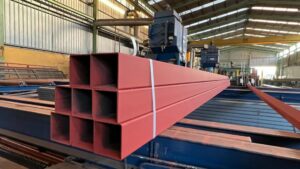Tata Steel, the largest steelmaker in the UK, is installing digital scanning technology at its no. 5 blast furnace at Port Talbot in South Wales to reduce the amount of coke used in the furnace, assisting decarbonization. Similar technology was installed at the works’ no. 4 blast furnace in 2021.
The 3D scan technology, which monitors the blast furnace charging process, has the potential to save “millions of pounds every year” due to lower coke intake and will reduce CO2 emissions by at least 50,000 mt annually, the steelmaker said Nov. 17. The technology is also designed to improve the furnaces’ stability and efficiency, it said. The installation is expected to be completed by the end of November.
The CO2 savings are achieved via the more efficient use of coke and hot blast gas to reduce the iron ore input to iron, it said.
Tata Steel UK, with an annual crude steel capacity of 5 million mt/year, aims to reduce its total CO2 emissions by 30% by 2030 and be a CO2 neutral steelmaker by 2045, in support of the UK’s ambition to be net-zero by 2050.
The GBP1 million ($1.19 million) investment in ‘Topscan’ technology on the site’s blast furnace 5 complements a similar investment in 2021 on blast furnace 4, where considerable cost savings and lower emissions have already been registered, Tata Steel said.
The No. 5 blast furnace, with 10.8 meter hearth diameter and which produces some 6,000 mt of pure iron daily, underwent a life-extension project in 2018, which demonstrated Tata’s commitment to continued blast-furnace-based steelmaking and to its Port Talbot works, amid a period of speculation on the works’ future and talks with the UK and Welsh governments on potential financial support.
The India-based Tata Group has capacity for 34 million mt/year crude steel.
Topscan, manufactured by a company called Tapping Measuring Technology (TMT) uses a set of radars which take a full surface scan of the iron ore and metallurgical coke being laid into each furnace, every 10 seconds. Approximately 1,000 data points are measured every 10 seconds, said Tata Steel UK’s Blast Furnace Technical Manager Aaron Parsons.
Computer modeling gives a clear, finite view of the raw materials at the start of their journey through the furnace, Parsons said.
“The specific way in which we lay materials in the furnace is our main method of controlling gas flow up from the hot air blast through the raw materials,” Parsons said. ““Over time, we can make tweaks to the distribution allowing us to make the most efficient use of the hot gases and yield really big savings, both in terms of coke usage and CO2.”
The new system replaces seven static radars, which previously gave more approximate readings on the blast furnace charge. Changes to the blast furnace burden that previously would have taken weeks to analyze and implement can now be done in a matter of hours, according to the blast furnace manager.
Tata Steel UK announced in October that it had begun sales of certified low-CO2 steel to customers due to market demand for this type of steel.
The lower CO2 certified steel, named “Optemis Carbon Lite,” is based on CO2 savings achieved by Tata Steel in the UK and is verified by independent assurance experts DNV, a company spokesperson said in an email.
— Diana Kinch






